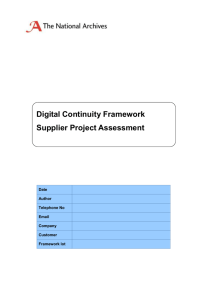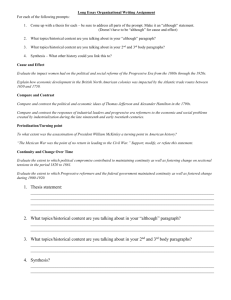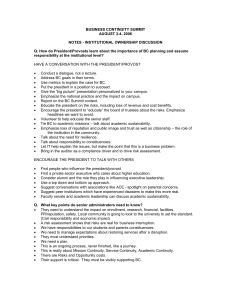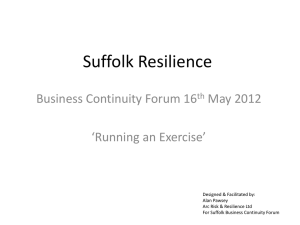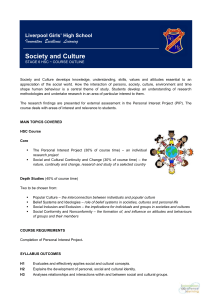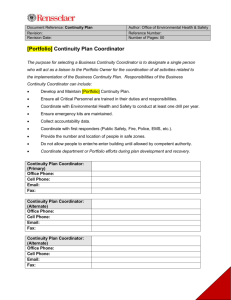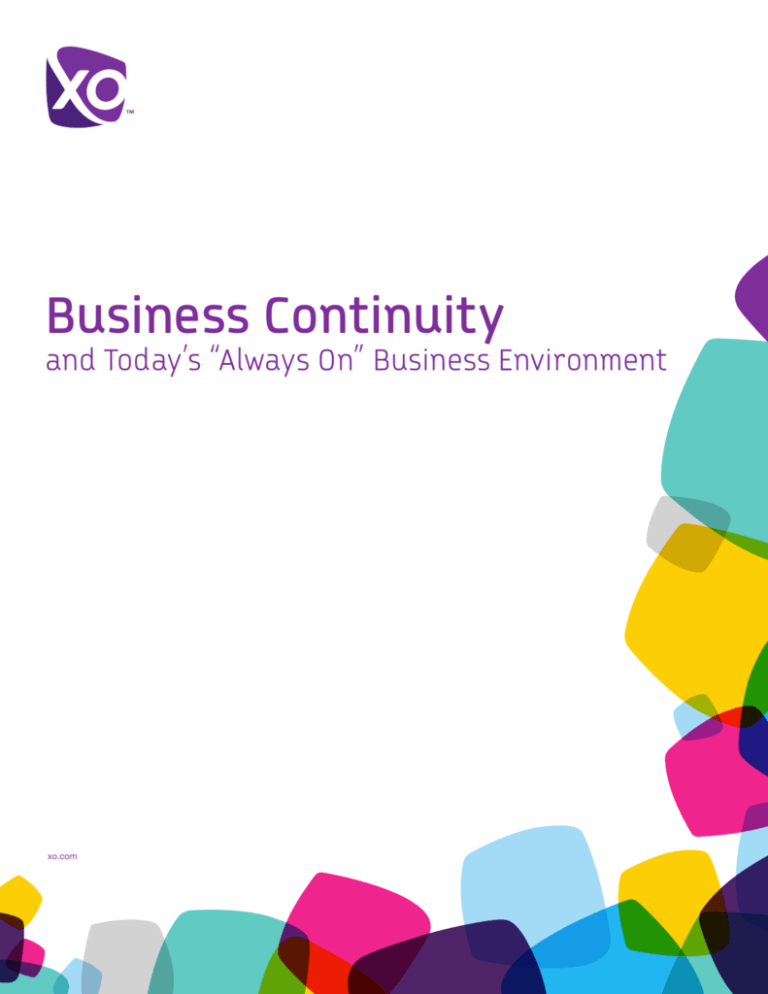
Business Continuity
and Today’s “Always On” Business Environment
xo.com
Business Continuity & Today’s “Always-On” Business Environment
www.xo.com
XO Communications
2
Services: VoIP ▪ Voice ▪ Network ▪ Internet & Hosted IT
www.xo.com
XO Communications
BUSINESS CONTINUITY
& TODAY’S “ALWAYS-ON”
BUSINESS ENVIRONMENT
Table of Contents
Crisis Management & Business Continuity
4
Business Continuity Management (BCM)
4
Types of Risk to Business Continuity
4
Elements of Business Continuity Planning
5
Effective Business Continuity Planning Strategies 5
XO Business Continuity Services
XO Network Protection Services
6
6
Voice Network Resiliency Services
7
Data Network Resiliency Services
7
XO Information Protection Services
8
XO Disaster Mitigation Services
9
“Always- On” Business Environments Require Strong Business Continuity Partners
9
References10
Copyright 2012. XO Communications, LLC. All rights reserved.
XO, the XO design logo, and all related marks are registered trademarks of XO Communications, LLC.
3
Business Continuity & Today’s “Always-On” Business Environment
Crisis Management
& Business Continuity
As the floods along the Red River in North Dakota and
Manitoba receded in the spring of 2009, officials began to
estimate the costs of clean up, and the costs of lost revenue
to local businesses. Several cities were endangered, including Winnipeg, Grand Forks, and Fargo. One early tally
estimated lost business revenue just in Fargo, a city with less
than 91,000 residents, at more than $100million.1
As terrible, destructive and costly as natural disasters like
floods, hurricanes, tornados, earthquakes and wildfires are,
they are relatively infrequent occurrences. But disruptions
to daily living and business operations occur every day.
Typically, disruptions are due to carelessness or accident, but
some are deliberate. Although it’s impossible to ensure that
natural or man-made disruptions will never impact a particular person or business, there are a number of actions that
can be taken to reduce the risk level and provide a means
of rapid recovery. This is the objective of sound business
continuity management practices.
BUSINESS CONTINUITY MANAGEMENT (BCM)
Fundamentally, business continuity management is a set of
coordinated plans and actions that mitigate and/or negate
the adverse effects natural and man-made events have on
key business operations.
Most companies already engage in business continuity
management practices to some degree. For instance, in the
U.S., occupants of large buildings are required by law to
practice fire drills at regular intervals. These drills help to
protect employees who work inside the building, and can
also help to protect the building and its contents. Good
business continuity management practices are necessary to
reduce the impact of a wide range of threats. They focus
on protecting and preserving employees, facilities, and key
resources, including essential company information housed
in storage arrays, servers and personal computers.
4
www.xo.com
The success of many companies’ ongoing operations
depends on continuous access to key IT assets, which are
usually accessed via network resources. Additionally, the
ongoing functionality of important business operations, like
call centers, can greatly depend upon both highly available
IT and network infrastructures. To help meet these needs,
XO Communications offers a broad portfolio of business
continuity services. They include network protection, data
and information protection, applications protection, and
disaster mitigation services – all of which will be discussed
in a later part of this white paper.
TYPES OF RISK TO BUSINESS CONTINUITY
Three main types of threat that can impede the continuity
of business operations include those that inhibit the use of
key company buildings and facilities, risks that that limit
the ability of employees to work at those facilities, and
threats that hamper the usefulness of key IT and network
resources. Without adequate preparation, each of these
critical company resources is vulnerable to natural and
man-made disasters:
Facilities
The impact of natural events, like fire, floods and hurricanes
can make it impossible to access a building for a prolonged
period of time. Man-made events can also impede access to
the worksite. In 2009, for more than a day, protests in London essentially closed the financial district, even to people
who work there.2
Workforce
Consider these scenarios—in recent years, terrorists disrupted train, subway and bus routes schedules in major
cities, making it impossible for commuters to travel to work.
Of broader and longer lasting impact is a pandemic—to
minimize casualties, the government could prohibit the
congregation of people (at places of work and elsewhere) for
extended periods of time.
IT Infrastructure
Security breaches or the unavailability of key IT and
network managers can diminish the usefulness of critical
business information located in data and network hubs.
Without sufficient backup power, brownouts and blackouts
in the electrical grid can crash servers, LAN and WAN
connectivity. Natural and man-made events can damage
Services: VoIP ▪ Voice ▪ Network ▪ Internet & Hosted IT
www.xo.com
XO Communications
key facilities, and thus render IT and network infrastructure inoperable. When considering the underlying causes of
business interruptions, only 3 out of 100 are caused by acts
of nature. In contrast, 32% of the business interruptions
are caused by human error, and 65% are caused by malfunctions in IT and communications hardware, software
or services. Approximately 11% of IT and network-related
malfunctions are directly caused by computer viruses.3
Regulation
Some regulations, like Sarbanes- Oxley, have broad scope
and far-reaching impact on business continuity and disaster
recovery planning. Among other provisions, it mandates
that publicly-held companies engage in certain business
continuity practices, particularly pertaining to data storage and archival. In some industries, possible risks to their
business operations are so great, and their potential impact
so pervasive that specific regulations have been enacted to
minimize their existence and effect. For instance the Health
Insurance Portability and Accountability Act (HIPAA),
Federal Energy Regulatory Commission (FERC), Federal
Information Security Management Act (FISMA), Payment
Card Industry Data Security Standard (PCI DSS), the Basel
ure
I de
Business
Continuity
Life Cycle
People.
Processes,
Systems
Design
Figure 1: Business Continuity Life Cycle
Key components of a business continuity plan include
documentation of the business operations that are included
in the continuity strategy, their threats and regulatory
requirements, and mediation and remediation activities.
The plan identifies the resources and personnel which
compose the business continuity team. These can be internal resources and personnel, and/or external ones. It also
contains information on the ROI of each business
continuity action. If certain internal or external company locations are designated to act as alternate locations
for some business continuity activities, this must also be
documented. Finally, to ensure continuity in the planning
process over time, some companies may elect to include
an appendix that lists business operations that were
excluded from the continuity plan, and the reason for
their exclusion. Figure 1 shows the Business Continuity
Life Cycle that businesses can use to conceptualize their
approach to business continuity planning.
Effective business continuity strategies rank the potential
effects of various threats to ongoing business operations.
They also employ both proscriptive and prescriptive remediation techniques, and use business case framework to assess
and compare risk and remediation costs:
Risk
Assessment
Business
Impact
Analysis
sis
ute
Exec
Plan,
Develop,
Execute
nt
An
aly
Test &
Maintenance
ELEMENTS OF BUSINESS CONTINUITY PLANNING
EFFECTIVE BUSINESS CONTINUITY
PLANNING STRATEGIES
ify
M
s
ea
II Accord and the Graham-Leach-Bliley Act each contain
requirements designed to assure the continuation of key
business operations in particular industries.
Rank Risk
Each organization should identify its key business activities and determine how long they can be forgone without
adversely impacting the company or its customers. In
addition to ranking these events by time, they also must be
ranked by their financial impact. When combined, companies use these two factors to assess high-medium-low
risks. For instance, an event that has immediate impact but
is financially small poses low risk and thus also has a low
recovery objective.
Employ Both Risk Avoidance and Remediation Tactics
To optimize the effectiveness of a business continuity plan,
effective strategies typically contain both proscriptive and
Copyright 2012. XO Communications, LLC. All rights reserved.
XO, the XO design logo, and all related marks are registered trademarks of XO Communications, LLC.
5
Business Continuity & Today’s “Always-On” Business Environment
prescriptive elements.
•
•
•
Proscriptive. To maximize agent productivity, it’s
fairly common for companies with large call center operations to deploy them in diverse geographic
regions, and to use IT and network technology to route
or transfer calls between the centers. Proscriptively, if
employees can’t get to their normal workplace during a blizzard, agents in other centers can handle their
calls. This essentially brunts virtually all of the adverse
impact to customers.
Prescriptive. Companies that employ just- in- time
inventory practices can be vulnerable to disruptions
experienced by primary shippers. Some of these businesses have made advanced arrangements to obtain
critical inventory via alternate shippers. A delay in
receiving inventory will occur, but it won’t be as disruptive as if no plans had been made.
Proscriptive and Prescriptive. Many organizations
back up critical IT data and processes, often in more
than one location. Such a strategy contains both risk
avoidance and business recovery elements.
Understand Total BCM Return on Investment (ROI)
Companies will develop and execute plans based on the
level of risk to ongoing business operations, recovery
objectives, and their avoidance and mitigation costs. In
the inventory example above, the company implemented
processes to reduce, not eliminate, the impact of disruptions
with primary shippers who supply critical inventory. In
theory, the company could employ other methods to reduce
the risk of running out of inventory, including stocking
large reserves on premises. But it has calculated that the
costs involved in such possible solutions outweigh the risk
and costs of its preferred approach
Key Stakeholders
The plan lists by name and function each member of the
business continuity team, their contact information and
alternates. The plan also contains information on their performance metrics. Without the involvement of key executives, a business continuity strategy runs the risk of being
nothing more than a document that gathers dust. Good
contingency plans assume that key executives won’t be able
to fulfill their normal duties during a crisis, and designates
and trains alternates.
6
www.xo.com
Training
Key internal and external personnel and their alternates
must be trained on the business continuity strategy and
plan, and their roles in fulfilling its objectives. This includes
key executives. The company should conduct drills to
familiarize personnel with plan enactment, and to identify,
remediate and re-test any weaknesses in the plan.
XO Business Continuity Services
To help companies assure that key business operations that
depend on highly available IT and network resources aren’t
impacted by natural and man-made crises, XO Communications offers a broad range of services that can help protect
IT applications, company data and networks.
XO NETWORK PROTECTION SERVICES
When considering business continuity management
practices, most companies assume the focus of their IT
infrastructure protection efforts will be on data network
preservation and restoration. And for small, medium and
large companies across diverse industries, this often is the
case. However, some companies’ key business operations
also depend upon the continuous availability of voice services. Companies with contact centers that support inbound
or outbound sales, or customer service, are clear examples. It
won’t take very long for a company to begin to lose revenue
if its customers can’t communicate with contact center
representatives during normal business hours. In addition,
employee access to internal resources, like IT help desk
or HR, can also depend on voice services. Particularly in
emergencies like hurricanes or tornados, these can be vital
resources for affected employees, and thus for the ongoing
operation of the business.
Many smaller businesses, or those with one primary location, may assume that network protection services are only
needed by medium and large companies—that it’s unlikely
that a single site won’t have access to the network for any
lengthy period of time. But if a backhoe mistakenly takes
out the main electrical or communications links into a
building, that business location will be off the grid for at
least several hours, and probably much longer. And just
like some man-made threats, many natural events, like
fire, tornado and flood, can render a site unusable for days,
weeks or months. Thus in some cases, companies with only
Services: VoIP ▪ Voice ▪ Network ▪ Internet & Hosted IT
www.xo.com
XO Communications
one main business location are more vulnerable to business
continuity threats than are larger companies with several
main business sites.
companies, even in the same industry, may have different
cost/risk profiles. To meet a wide range of needs, XO offers
a broad array of data network protection services:
Companies who are interested in assuring network
continuity will find that XO has a very broad portfolio of
services designed to protect both voice and data networks.
And since these networks connect to IT resources through
network access and premises equipment like routers, XO
offers a range of services to protect these assets as well.
They include:
Fixed Wireless Access Diversity
To ensure the ultimate in access diversity and availability,
XO’s Nextlink broadband fixed wireless access service can
be used to backup any type of dedicated access that is connected to either voice or data services, or both.
Voice Network Resiliency Services
XO offers a range of services to support inbound and outbound calling requirements:
Inbound Call Re-Routing
XO offers several different automatic call re-routing features
designed to protect important inbound calls and contact
center applications. In addition, some companies make
extensive use of Interactive Voice Response (IVR) applications for use internally, or for use by customers, suppliers
and key partners. XO provides hosted voice XML services
that can be deployed on a dedicated server in XO’s hosting center. For customers who are interested in minimizing
costs, XO also offers hosted voice XML service on a shared
platform. To assure availability, XO’s resources are housed
in multiple data centers deployed across the U.S.
Outbound Call Re-Routing
For some companies, their business continuity requirements
dictate the preservation of both incoming and outgoing
call connectivity. XO provides features to support this—for
both traditional PSTN calls and VoIP calls.
Administration
XO provides customers with a broad range of tools to
administer and manage their voice protection services as
they need to, on a round the clock basis. These self-service
tools include basic touch tone access and web-based access.
Data Network Resiliency Services
Good business continuity practices attempt to balance the
costs of implementing data network continuity practices
against the importance of the activity to continuing operations, and the likelihood a problem will occur. Different
Landline Access Diversity
At a customer’s request, XO will deploy diversely routed
landline access from its point of origin at the customer
premises to its network node and beyond. To ensure the
highest levels of continuity of key data-oriented business
applications, customers may employ either landline or fixed
wireless access diversity in conjunction with IP or MPLS
load sharing or multi-homing networks.
Multi-Homing Networks
Companies who are interested in ensuring uninterrupted
data network connectivity between select sites can use
techniques like load sharing or multi-homing on both XO’s
MPLS IP-VPN and dedicated Internet access services.
High-Bandwidth Network Transport Solutions
Companies with very large file transfer requirements, or
who are in heavily regulated industries like healthcare
or financial services, will be interested in using highbandwidth dedicated private line services to construct fully
redundant, geographically diverse networks between large
data centers. XO’s private line services use a variety of stateof –the-art WAN technologies, including Ethernet and
wavelength services.
Collocation
XO makes its highly secure, carrier grade environment with
redundant power supplies available to customers for collocation. Although some companies use co-location as a backup
to premises-based web and applications servers, others who
want to totally eliminate the threat posed by access unavailability will co-locate key servers in XO’s data centers.
Applications Performance Management
These begin with XO’s three tiers of application performance management tools, which customers can use to spot
and remediate potential problems in their MPLS-based
networks before they do any damage.
Copyright 2012. XO Communications, LLC. All rights reserved.
XO, the XO design logo, and all related marks are registered trademarks of XO Communications, LLC.
7
Business Continuity & Today’s “Always-On” Business Environment
Remote VPN
Companies who want to ensure that employees can access
important computing resources without interruption will
employ Internet VPN backup services, which are available
on a broadband or dial-up basis.
Figure 2 summarizes the different types of data network
and CPE diversity and the levels of protection they provide.
Figure 3 outlines the risks and costs trade-off for certain
types of data network protection.
Medium
Protection
Capability
High
Protection
Very High
Protection
Wireless Access as Backup
Full Access Diversity
Redundant Access, Single Router
Redundant Access, and
Multiple Routers
Redundant Access with Diverse
Network Gateways
Diverse Carriers
Collocation Only
Collocation with Access Diversity
Collocation with Hardware
and Access Diversity
High
Figure 2: Protecting Access and CPE Levels of Protection
Cost $$$
Diverse Carriers
Multi-Homing
VPN Remote Back-Up
Low
Applications Preformance
Management
Low
Level of Protection
High
Figure 3: Risk/Cost Trade-Off for Data Protection Options
XO INFORMATION PROTECTION SERVICES
Irrespective of where they are housed, key IT and network
resources must be protected against security and survivabil-
8
www.xo.com
ity threats. XO offers both premises-based managed services
and hosted services to help protect your organization’s
information. They include:
Managed Backup
XO’s state of the art remote backup service combines WAN
and remote access resources with the resources of XO’s
cloud computing platform to deliver a round the clock,
highly automated, efficient, cost-effective and scalable
service that protects data housed in popular software like
Oracle databases and Microsoft Exchange, and across a
wide variety of operating systems commonly deployed in
servers, desktop PCs and notebooks. By employing 128-bit
AES encryption, the service is highly secure. Finally, it provides easy to use web-based tools for customers to manage
and retrieve stored data.
Email Filter and Authentication
For customers that house email in their own servers, XO
offers a Perimeter email Protection (PEP) service that stops
spam and filters viruses before they arrive at the server. It
also prevents other types of malicious behavior, including
phishing, DDOS, secondary attacks, and directory harvesting. This service, developed by XO, is identical to the
one employed in XO’s hosted Exchange and web hosting
services, and works with all major brands of email software.
Critical to any business continuity strategy is planning for
email server unavailability. Should the server be unable
to receive email for a period of time, PEP will store up to
5 days of incoming email at no charge, and deliver it to
the customer’s email server as soon as it has been restored.
Introduced in 2006, XO’s PEP service includes companies
in IT, professional services and retail industries.
Managed Security Solutions
In addition to email filtering and authentication, XO offers
a very scalable, managed security solution which includes
an Internet firewall service that can be located either on
the customer’s premises or in the XO network. The latter
approach can be cost effective because it assures that access
trunks are utilized only for authorized applications and
users, and don’t experience congestion caused by security
breaches. XO’s Cisco-certified managed firewall service was
introduced more than ten years ago and is used by many
industries, including finance, healthcare and retail. XO also
offers a service that bundles managed firewall with managed VPN services.
Services: VoIP ▪ Voice ▪ Network ▪ Internet & Hosted IT
www.xo.com
XO Communications
Dedicated Web Hosting
Companies with mission-critical web applications, including e-commerce, are very interested in assuring their high
survivability and availability. To support this, XO developed its own patented clustered web hosting platform.
Types of industries that use XO’s hosted e-commerce service
include IT services, professional services and retail.
“Always- On” Business
Environments Require Strong
Business Continuity Partners
XO DISASTER MITIGATION SERVICES
•
Since it’s not possible to prevent all crises from affecting
business operations, XO also offers a range of services to
mitigate their ill effect and help ensure organizations can
maintain communications with employees, customers and
partners during a disaster. These include:
Protect revenue, ensure employee productivity and
protect your company’s ability to serve its customers
without interruption.
•
Ensure compliance with government mandated
regulations and industry guidelines that require your
company to implement and maintain business continuity plans; and
•
Proactively protect your company’s IT infrastructure
against many types of events that can negatively impact
your business. Given their increasing frequency, these
safeguards extend to protecting your company from
security threats to IT and network resources.
Teleworking Services
These include tools to support both voice and data applications, enabling employees to work virtually from any
location. To protect against the unavailability of key IT and
network resources housed in particular facilities, XO offers
network-based web conferencing, audio conferencing, voicemail and email services. In addition, by using XO Anywhere service, employees can turn any phone into their XO
office phone line because the service operates independently
of PBXs or key systems (these can be unavailable in the
event of a facilities-related emergency). XO’s VPN remote
access service, discussed in an earlier section, can be used
to connect remote employees to a particular location to still
access its computing resources.
Multi-Media and Outbound Notification Services
Employees who are part of the business continuity team
must be able to communicate with each other, and with
other employees, as soon as an emergency occurs. Organizations may also need to communicate with people in other
companies, with customers, or with key emergency services
personnel. XO Connect, a multimedia notification service,
supports the broadcast of messages across a variety of media,
including text messages, email and voice calls. XO’s Interactive Voice Response (IVR) services can also be used to
support a company’s employee notification requirements.
In today’s “always-on” business environment, creating and
implementing a business continuity and disaster recovery
plan is critical in order to:
XO Communications has one of the nation’s largest and
most technologically advanced nationwide networks. Its
architecture provides a unique balance between cost effectiveness and requirements to maximize performance and
availability With XO Communications as your business
continuity partner, you can have solutions that deliver bottom line benefits to help you:
•
Protect Your Network
•
Protect Your Information & Data
•
Mitigate Disruption
Copyright 2012. XO Communications, LLC. All rights reserved.
XO, the XO design logo, and all related marks are registered trademarks of XO Communications, LLC.
9
Business Continuity & Today’s “Always-On” Business Environment
www.xo.com
Objective
XO Service
Benefit
Protect My
Network
Wireless Network Resiliency
Provides back-up connection via high-speed broadband
wireless connections
Dedicated Internet Access
Redundancy and Re-Routing
Ensure availability of applications and access with backup or shared IP ports when primary IP port is unavailable
MPLS IP-VPN
High-performance private wide area network solution
for primary or as “always-on” back-up network
High-Bandwidth Network Transport
Provides additional layer of network resiliency with
Ethernet and wavelength services for connecting locations
and data centers
Collocation
Provides secure back-up facilities for data
center operations
Applications Performance
Management
Proactive monitoring of applications and network
performance so issues can be better anticipated
Voice Re-Routing and Redundancy
Services
Ability to re-route inbound large call volumes to alternate
locations or phone numbers
MPLS IP-VPN
Ensures data traffic transmitted across network does
not touch the public Internet
Managed Security
Protection for data against outages from hacking
and viruses
Managed Backup
Data back-up to remote location with full restore back
to primary data center
Perimeter Email Protection
Filters and scans email to reduce spam and viruses and
backs up email after an outage
Web Hosting
Facilitates ongoing web operations during an outage
because server is hosted by XO
Teleworking
Allow employees to work anywhere with unified
communications, conferencing, remote VPN and
hosted email services
Notification Services
Provides voice and multi-media communication tools for
notifying employees, customers and partners in the event
of an outage
Protect My
Information
Mitigate
Disruption
Services may not be available in all areas.
References
1. “Bill Rolls in for Red River Flooding”, Minnesota Public Radio, April 6, 2009
2. “G20 Protests: Riot Police Clash with Demonstrators”, the Guardian, April 1, 2009.
3. “Techniques, Tips and Technologies for Business Continuity Planning”, Computer Associates webinar, 2004.
10
Services: VoIP ▪ Voice ▪ Network ▪ Internet & Hosted IT
www.xo.com
Copyright 2012. XO Communications, LLC. All rights reserved.
XO, the XO design logo, and all related marks are registered trademarks of XO Communications, LLC.
XO Communications
11
About XO Communications
XO Communications is a leading nationwide provider of advanced broadband communications services and solutions for businesses, enterprises, government, carriers and service
providers. Its customers include more than half of the Fortune 500, in addition to leading cable
companies, carriers, content providers and mobile network operators. Utilizing its unique
combination of high-capacity nationwide and metro networks and broadband wireless capabilities, XO Communications offers customers a broad range of managed voice, data and IP
services with proven performance, scalability and value in more than 85 metropolitan markets
across the United States. For more information, visit www.xo.com.
For XO updates, follow us on: Twitter | Facebook | Linkedin | SlideShare | YouTube | Flickr
© Copyright 2012. XO Communications, LLC. All rights reserved.
XO, the XO design logo, and all related marks are trademarks of XO Communications, LLC.




